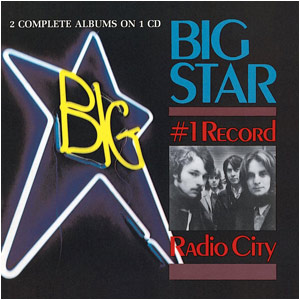
#1 Record/Radio City
Ardent/Stax
It’s been told countless times how Big Star, like the Velvet Underground before them, never sold many records but nonetheless were an influence on all who did happen to hear them. So there's no point in rehashing their impact on such bands as R.E.M., Teenage Fanclub, and the Replacements. But there’s good reason why Paul Westerberg and the like “never travel(ed) too far without a little Big Star.”
Two of those reasons, namely the two albums the band released during its lifespan, #1 Record and Radio City, are being reissued on one CD, just as they were when originally released on the format in 1992, as well as two separate LPs that include original artwork and labeling.
Originally issued in 1972, the appropriately titled debut, #1 Record, captures Big Star in its original formation: Alex Chilton on guitar and handling the majority of the vocals; Chris Bell also on guitar; Andy Hummel on bass; and Jody Stephens on drums. With Bell’s Anglophilic tendencies paired to Chilton’s Southern soul background (he’d previously scored a big hit with “The Letter” as leader of the Box Tops), the band had a pop knack countered by an underlying gritty countenance. Ahead of their time—or at least apart from it—and its pervasive flowery prog-rock, the Big Star of this period was at once anachronistic in its love of ’60s-style melodies while also tapping into something much deeper. “Thirteen” hints at Help!-era Beatles (though it mentions “Paint It Black” by name), but placed between “In the Street” and “Don’t Lie to Me,” two songs that could serve as audio definitions of “power-pop,” it seems even more classicistic. So too with “The India Song,” which brings to mind the Left Banke.
Bell left Big Star by the end of ’72, and his absence can be heard on Radio City, though not necessarily negatively. Without Bell’s mellifluous guitar lines as counterpoint, Chilton’s jagged riffs and penchant for erratic song structures take prominence, again not necessarily a bad thing. Brian Hogg, in his liner notes from 1986, describes the record as having a “feeling of imminent collapse,” but I think what he was hearing was Chilton’s ability for implication. No longer did every note needed to be played, it could simply be hinted at. That’s the case on “Life Is White,” where Chilton evokes a certain amount of melancholy over a melody that’s hardly there as the song is carried by the harmonica and bass, and later, piano. This album’s highlight, “What’s Going Ahn,” is much darker, predicting posthumously released material like “Big Black Car.” Hogg is right too, though, because cuts like “Mod Lang” seem particularly shambolic, but again not suffering for it.
Overstating the greatness of these records—and Big Star in general— would, once again, be regurgitating a good deal of what’s been said before. It bears repeating, I guess, but not too much. This edition of this twofer only tacks on a couple bonuses, some single versions of “In the Street” and “O My Soul;” the rarities have no doubt been saved for Rhino’s big boxset to be released at the beginning of September. But it’s the remastering and improved sound that earn kudos. (Isn’t it ironic that now that CDs have the capability to sound almost as good as an album they are being rendered obsolete by an inferior format?) One has really never heard enough Big Star, and this set makes that fact doubly so.
Stephen Slaybaugh
PAST PERFECTS
Various Artists, Smart's Palace
Miles Davis, Sketches of Spain
39 Clocks, Zoned
Company Flow, Funcrusher Plus
Nick Cave & the Bad Seeds, From Her to Eternity, The Firstborn Is Dead, Kicking Against the Pricks, and Your Funeral... My Trial
Stark Folk, Stark Folk
Dntel, Early Works For Me It It Works For You II
Cocteau Twins, The Pink Opaque
Ray Charles, Genius: The Ultimate Ray Charles Collection
Red Red Meat, Bunny Gets Paid
Chris Darrow, Chris Darrow and Under My Disguise
Beth Orton, Trailer Park
Various Artists, Downriver Revival
Isaac Hayes, Black Moses and Juicy Fruit (Disco Freak)
